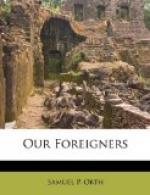On the revocation of the Edict of Nantes by Louis XIV in 1685 French Protestants fled in vast numbers to England and to Holland. Thence many of them found their way to America, but very few came hither directly from France. South Carolina, Virginia, New York, Rhode Island, and Massachusetts were favored by those noble refugees, who included in their numbers not only skilled artisans and successful merchants but distinguished scholars and professional men in whose veins flowed some of the best blood of France. They readily identified themselves with the industries and aspirations of the colonies and at once became leaders in the professional and business life in their communities. In Boston, in Charleston, in New York, and in other commercial centers, the names of streets, squares, and public buildings attest their prominence in trade and politics. Few names are more illustrious than those of Paul Revere, Peter Faneuil, and James Bowdoin of Massachusetts; John Jay, Nicholas Bayard, Stephen DeLancey of New York; Elias Boudinot of New Jersey; Henry Laurens and Francis Marion of South Carolina. Like the Scotch-Irish, these French Protestants and their descendants have distinguished themselves for their capacity for leadership.
The Jews came early to New York, and as far back as 1691 they had a synagogue in Manhattan. The civil disabilities then so common in Europe were not enforced against them in America, except that they could not vote for members of the legislature. As that body itself declared in 1737, the Jews did not possess the parliamentary franchise in England, and no special act had endowed them with this right in the colonies. The earliest representatives of this race in America came to New Amsterdam with the Dutch and were nearly all Spanish and Portuguese Jews, who had found refuge in Holland after their wholesale expulsion from the Iberian peninsula in 1492. Rhode Island, too, and Pennsylvania had a substantial Jewish population. The Jews settled characteristically in the towns and soon became a factor in commercial enterprise. It is to be noted that they contributed liberally to the patriot cause in the Revolution.
While the ships bearing these many different stocks were sailing westward, England did not gain possession of the whole Atlantic seaboard without contest. The Dutch came to Manhattan in 1623 and for fifty years held sway over the imperial valley of the Hudson. It was a brief interval, as history goes, but it was long enough to stamp upon the town of Manhattan the cosmopolitan character it has ever since maintained. Into its liberal and congenial atmosphere were drawn Jews, Moravians, and Anabaptists; Scotch Presbyterians and English Nonconformists; Waldenses from Piedmont and Huguenots from France. The same spirit that made Holland the lenient host to political and religious refugees from every land in that restive age characterized her colony and laid the foundations of the great city of today. England had to wrest from the Dutch their ascendancy in New Netherland, where they split in twain the great English colonies of New England and of the South and controlled the magnificent harbor at the mouth of the Hudson, which has since become the water gate of the nation.




